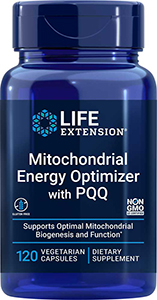RECOMMENDATION NO 5

Support Youthful Cellular Energy
Youthful cellular energy is key to longer youth, longer life. And Mitochondrial Energy Optimizer with PQQ is a state-of-the-art nutritional formula that can help you take better care of the little powerhouses in every cell in your body … by protecting delicate cellular structures, enabling cells to perform life-sustaining metabolic processes, even helping generate new mitochondria! This innovative formula helps counteract age-related structural and functional changes and promote the growth of new mitochondria with these unique ingredients:
- PQQ (Pyrroloquinoline quinone) — triggers growth of new mitochondria in aging cells1 … and activates genes involved in protecting delicate structures within the mitochondria.2-6
- Carnosine —As humans age, proteins in their bodies become irreversibly damaged by glycation reactions.7 Glycation can lead to alterations of normal cell function.8,9 Carnosine is a powerful anti-glycating agent, and protects neurons against reactive and cytotoxic protein carbonyl species associated with normal aging.10-16
- Luteolin — Systemic inflammation is involved in most consequences of aging.17,18 Culprits behind inflammatory reactions are pro-inflammatory cytokines, such as interleukin-1 and tumor necrosis factor-alpha. Luteolin is a flavonoid that has been shown to help suppress these inflammatory cytokines.19-35
- Benfotiamine — Human mortality studies indicate that ideal fasting glucose levels are between 70–85 mg/dL. Yet many aging people have fasting glucose above 90 mg/dL, which is not optimal. Benfotiamine can activate glucose metabolism and promote already healthy blood glucose levels. In addition, benfotiamine exhibits direct antioxidative capacity and supports healthy DNA function.36-40
- Pyridoxal 5’-Phosphate — the active form of vitamin B6 that has been shown to protect against both lipid and protein glycation reactions.41-47
- R-Lipoic Acid — facilitates youthful mitochondrial energy output while guarding against free radicals. Two forms of lipoic acid are sold on the supplement market, but R-lipoic acid is far more potent.48-55
- Taurine — this amino acid supports neurite growth56 and powerfully protects the mitochondria57 from oxidative damage to enhance energy production within cells.56,58,59 Taurine is prevalent throughout the body60 and found in especially high amounts in the metabolically active cells that require high mitochondrial energy production (brain,60 nerve, and eye cells61 and heart62 and skeletal muscle63).
+
1. J Biol Chem. 2010. Jan 1;285:142-152.
2. Alt Med Rev. 2009; 14(3):268-77.
3. Entrez Gene: PPARGC1A peroxisome proliferator-activated receptor gamma, coactivator 1 alpha [ Homo sapiens ] GeneID: 10891.
4. Entrez Gene: CREBBP CREB binding protein [ Homo sapiens ] GeneID: 1387.
5. Hum Mol Genet. 2008 Nov 1;17(21):3357-67.
6. Metabolism. 2008 Oct;57(10):1452-7.
7. Diabetologia. 2002 Oct;45(10):1457-62.
8. Pathol Biol (Paris). 2003 Dec;51(10):543-9.
9. Brain Res Brain Res Rev. 2003 Mar;41(2-3):306-23.
10. Arthritis Rheum. 2004 Apr;50(4):1207-15.
11. Med Hypotheses. 2004;62(2):275-9.
12. Can J Physiol Pharmacol. 2000 Oct;78(10):848-55.
13. Ann N Y Acad Sci. 2001 Apr;928:48-53.
14. Arthritis Rheum. 2002 Jan;46(1):114-23.
15. J InvestDermatol. 2002 Aug;119(2):489-98.
16. Kurume Med J.2002;49(1-2):7-13.
17. Curr Pharm Des. 2008;14(10):946-52.
18. Life Sci. 2007 Nov 30;81(23-24):1602-14.
19. J Nutr. 2006 Jun;136(6):1517-21.
20. J Neuroinflammation. 2008 Sep 25;5:41.
21. Immunology. 2005 Jul;115(3):375-87.
22. Am J Respir Crit Care Med. 2002 Mar 15;165(6):818-23.
23. Eur J Pharmacol. 2006 Jul 10;541(1-2):95-105.
24. Neurosci Lett. 2008 Dec 26;448(2):175-9.
25. Biochimie. 2011 Mar;93(3):506-12.
26. J Pharmacol Exp Ther. 2011 Sep;338(3):1013-22
27. Int J Neurosci. 2011 Jun;121(6):329-36.
28. Nat Med. 2003 Mar;9(3):294-9.
29. J Am Soc Nephrol. 2011 May;22(5):914-26.
30. Pharmacol Res. 2010 Jun;61(6):482-8.
31. Diabetes Care. 2006 Sep;29(9):2064-71.
32. Circ Heart Fail. 2010 Mar;3(2):294-305.
33. Acta Diabetol. 2001;38(3):135-8.
34. Diabetes Metab Res Rev. 2008 Jul-Aug;24(5):371-7.
35. Biochem Biophys Acta. 2001 Feb.14;1535(2):110-9.
36. J Lipid Res. 2006 May; 47(5): 964-74.
37. J Am Soc Nephrol. 2005 Jan;16(1):144-50.
38. Life Sci. 1988;43(21):1725-31.
39. Amino Acids. 2012 Apr;42(4):1163-70.
40. FASEB J. 1999 Feb;13(2):411-8.
41. Antioxid Redox Signal. 2000 Fall;2(3):473-83.
42. FASEB J . 2001 Mar;15(3):700-6.
43. Arch Biochem Biophys. 2004 Mar 1;423(1):126-35.
44. Redox Rep. 2005;10(1):52-60.
45. Altern Med Rev. 2007 Dec;12(4):343-51.
46. Neurosci Lett. 1994 Jan 3;165(1-2):33-6.
47. Neurochem Res. 1995 Jan;20(1):1-9.
48. Altern Med Rev. 2005 Dec;10(4):268-93.

